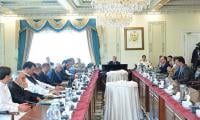ISLAMABAD: Almost all power sector specialists are keen to know what magic wand the government has to end increase in circular debt by December 2020 and believe the fate of government’s resolve in this regard will be no different from what happened to gas reserves from Kekra-1 touted by the government. These days Federal Minister for Power Division Umar Ayub mentions in almost every presser that the monthly flow in circular debt that was Rs38 billion has been brought down to Rs26 billion which will decrease to Rs8 billion by June 2020 and to zero by December 2020.
The minister also claims that the Power Division has managed to mop up Rs81 billion after a crackdown on the power thieves. About Rs58 billion has been collected from theft control.
Prime Minister Imran Khan is also praising the Power Division for doing wonders. The Power Division is also taking credit for zero loadshedding on 80 percent power feeders.
First of all, the existing circular debt of about over Rs1.4 trillion will continue to remain very much there, but the government’s claim that the monthly flow in circular debt will end by 2020 is contested by the eminent power sector experts. Former managing director of Pepco Tahir Basharat Cheema said the project for upgradation of transmission lines, including the grid stations at Rawat, Charsadda, Gatti and other points, had started in the last years of PML-N government tenure, which had now completed reducing power outages.
No doubt, he said, the PML-N government remained focused on the power supply side and added additional 11,000MWs to the system, but it initiated projects to improve transmission and distribution system in its last years.
Cheema admits that the PTI government has initiated a campaign against power theft and managed to increase revenue by Rs81 billion, but he thinks it is the result of a campaign which is short-lived and cannot be maintained on long-term basis. He said in the past such campaign was initiated 53 times and the required results were managed.
He said the PTI government had touted the campaign too much due to which it seemed the campaign was being launched for the first time.
Cheema said in the last seven months, recovery of power bills remained at 87 percent meaning that the power sector sustained 13 percent losses in last seven months. However, in the last three months the government started a campaign with dividends of Rs81 billion but it would be short-lived. As far as the claim to end circular debt by December 2020 is concerned, he said it was impossible because there was no sustainable mechanism to ensure there was no circular debt in future.
Cheema said recovery of power bills and electricity theft control were directly linked with the state writ, which was still week in many pockets of the country. “Suppose, the state establishes its writ in some problematic areas. Even then the paying capacity of people dwelling there is very poor. In this case, the role of the state becomes greater and it has to safeguard the people of the said areas with provision of electricity by giving subsidy,” he said.
Currently, the revenue based method of providing electricity is being implemented which is why massive load shedding in areas of Hesco, Pesco, Quesco and Pesco is still underway. This approach is inflicting a huge damage on the federation which is already very fragile.
Hesco, Pesco, Quesco, Pesco and Mepco are loss-making entities and their loss adds to the circular debt every month. For example, the losses of Hesco stands at 30 percent and Nepra allowed 21 percent losses in tariff, but the remaining 9 percent losses are automatically included in the circular debt. Similarly, the other loss-making Discos contribute sizeable loss to circular debt on a monthly basis. So the claim of the government to bring circular debt down to zero will not be achieved. However, there is a way out under which if burden of all kinds of inefficiencies in the power sector, including the load of actual line losses, is shifted to law abiding and compliant consumers, then circular debt will not emerge. However, this is simply not possible in the presence of Nepra.
At present, permissible line losses in the tariff stand at 16.3 percent which were increased from 13.2 percent in 2014 under the pretext that there are some areas where law and order situation is worst and recovery of electricity bills is not possible. In some areas, Raddul Fasaad followed by Zarb-e-Azb military operations were launched. Mr Cheema says now the situation has changed and it is high time to reduce the permissible loss back to 13.2 percent to provide the relief to the end consumers.
When it comes to the government claims of no loadshedding on 80 percent feeders, Mr Cheema said that it was weather-driven as in the month of April mercury remained at 23 degree centigrade which was the lowest one in last 40 years according to MET office which’s why the demand of the electricity did not increase as the air conditions were not on in April.
He said temperature in March and April remained lower by 4 degree centigrade if compared with the same months last year. He said the more system generates electricity the more loss on account of recovery, theft and line losses the government will face.
He also argued that increase in power tariff had played role in collection of more revenue, but continued inefficiencies were very much there and compliant consumers were paying more to offset the losses incurred because of inefficiencies in containing theft, line losses, and recovery.
Mr Arshad H Abbasi, eminent energy expert associated with SDPI, said that bringing circular debt down to zero was not possible as the government claims that line losses stand at 18.7 percent which is otherwise as it hovers over 25 percent.
He said power tariff had increased which is why collection target had improved. He said an official in the Power Division, who came from NESPAK, was misguiding the PTI leadership that circular debt will vanish by end 2020.
Abbasi raised the question if the existing CEOs of DISCOs has have started performing in containing theft, then has the top officials in power division has taken the action against the predecessor CEOs of DISCOs for their failures, Mr Abbasi said questioning who will audit that the claim of the government to collect Rs81 billion after taking action against those involved in electricity theft.
One of the power sector expert in Nepra who wants not to be named said that unless all the Discos are handed over to private sector management under Public Private Partnership (PPP) mode there will be no improvement in bringing down losses and containing the theft. At present, bureaucracy and government functionaries are running the Discos with no ownerships as they know they will have the salary at the end of every month at any cost as they are regular employees of the government and when DISCOS are operated by private sector under PPP mode then there will be ownership by the management and will run the DISCO professional.
He also said that bringing down one percent loss is not a joke as it requires many efforts. He referred to the K Electric saying when it was privatised its loss stood at 34 percent which after 11 years efforts came down to 20 per cent. Since the line losses are part of circular debt and coping with losses is not an easy job as it requires incessant efforts so doing away with the circular debt till end 2020 is not possible.
The Joint Secretary (Power) Zargham Eshaq Khan who as carved out the plant to end circular debt by end next year has not shared it with regulator so the top officials in NEPRA also don’t know what magic wand Power Division has to end the circular debt till December 2020.
Justice Tariq Mehmood Jahangiri took up Sher Afzal bail plea for hearing
CCP’s announcement made, stating that applicants are required to pay money upfront in order to enroll
According to details, the police took a van filled with female students of medical college to a police station on...
In this image, the logo of the Nowshera Press Club can be seen. — Facebook/Nowshera Press Club/FileNOWSHERA: The...
Senator Sherry Rehman said the PPP had previously extended an offer to the PTI to form a government, but the PTI is...
A division bench comprising Justice Shakeel Ahmad and Justice Dr Khurshid Iqbal heard the petition filed by the KP...







